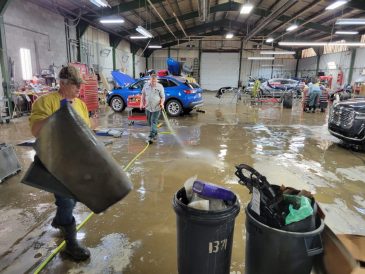Flash flood warnings issued by NWS in Pittsburgh up significantly in 2025
Region has seen more than twice the number compared to annual average
 Mike Jones/Observer-Reporter
Mike Jones/Observer-Reporter
The power and frequency of severe storms hitting the area have increased significantly this year, as illustrated by the National Weather Service in Pittsburgh issuing more than double the number of flash flood warnings through the first seven months of 2025 than is typically seen in an entire year.
The weather service has issued 114 flash flood warnings for its coverage area in Western Pennsylvania, Northern West Virginia and Eastern Ohio, which dwarfs the average of 51 total warnings annually going back to 2014, NWS meteorologist Colton Milcarek said.
“We’re definitely well above average,” Milcarek said.
This year has seen the most flash flood warnings year to date since 2003, Milcarek said. He noted that a higher than usual dew point means there is more potential for stronger storms since there is more moisture in the air, along with weaker air flow that keeps the systems hovering over one area and allowing it to drop more rainfall.
“More moisture in the atmosphere this summer than normal is able to produce more rainfall and rates. Weak flow also keeps storms in place longer,” he said. “It’s why it’s been pretty active across the summer.”
With more frequent storms dumping increasing amounts of rain, counties and municipalities are now planning how to handle and divert additional stormwater runoff to prevent flooding.
Jordan Cramer, who is South Strabane’s fire chief and the assistant township manager, said the municipality began tracking and documenting heavy storms a couple of years ago and began making plans to upgrade its stormwater management system, which he admitted is a costly endeavor.
“We don’t have a lot of bodies of water, but we do have the potential for rapid rainfall overrunning our storm systems very easily in our municipality. We’re trying to work to prepare on the emergency services side to get our folks trained up on water rescue,” he said, adding that they’re also searching for state and federal money to upgrade the township’s stormwater management. “It’s no secret the water we’re having to handle is increasing over the years and essentially our storm water systems are not able to handle what is required. Unfortunately, it’s expensive to find a way to handle this.”
Cramer said following the June 14 storm that caused flash flooding in the Washington area, emergency officials conducted over a hundred surveys in South Strabane to document problems areas, which were mainly concentrated on Oak Springs Road, Locust Avenue, Manifold Road and East Beau Street. A drainage pipe became washed out under Berry Road, forcing its closure with no timeline for the road to reopen. The surveys will help in the future when the township tries to secure grant funding for the costly stormwater management project.
“We need to plan for the future how we can work with the data of the flooding we’re seeing,” Cramer said. “We’re going to be calling on folks (in the state legislature) and county to get funding, because all of these projects are extremely expensive to mitigate this in the future.”
While Greene County has mostly been spared from torrential downpours and flooding this summer, Emergency Management Director Rich Policz said they’re still able to lend a hand through cooperation agreements with neighboring counties and states.
The Quad State Emergency Management Partnership that includes Pennsylvania, Ohio, West Virginia and Maryland streamlines dispatching local crews to flood-ravaged areas elsewhere, or makes the process easier to accept help. In addition to Greene County sending fire trucks and ambulances across state lines, Policz said emergency responders from North Strabane went to Wheeling, W.Va., to help with its June 14 flood response, and crews from Washington, Fayette and Westmoreland counties went to Allegany County, Md., following the flooding there in early June.
“We are working and we’re seeing (the need) for cooperation,” Policz said. “We’re learning in these economical times it’s best to work together and join forces.”
Planning and coordination between county and municipal officials is also key, according to Fayette County Emergency Management Director Roy Shipley. He said they’ve had numerous discussions over the years about the county’s hazardous mitigation plan. The county requests input from the local municipalities, then organizes the plan and shares it with the townships and boroughs so they can take action.
“Things they can do are already listed in the plan,” Shipley said.
But the increasing intensity of storms is concerning to Shipley, who has noticed more damage in recent years, even if Fayette County has mostly avoided the worst of it so far this year.
“Especially this year and even last year, there have been a lot more (storms) than I’ve seen in the past during my career,” Shipley said. “Everyone is aware of it and everyone is looking into what they can do to help. It is a concern.”

